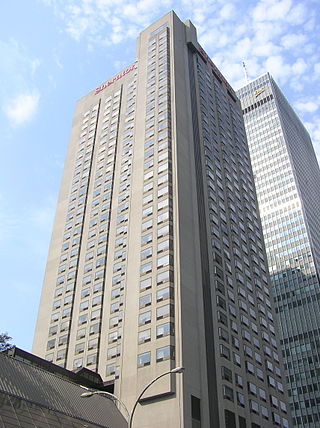
A kitchen is a room or part of a room used for cooking and food preparation in a dwelling or in a commercial establishment. A modern middle-class residential kitchen is typically equipped with a stove, a sink with hot and cold running water, a refrigerator, and worktops and kitchen cabinets arranged according to a modular design. Many households have a microwave oven, a dishwasher, and other electric appliances. The main functions of a kitchen are to store, prepare and cook food. The room or area may also be used for dining, entertaining and laundry. The design and construction of kitchens is a huge market all over the world.

Florence Delorez Griffith Joyner, also known as Flo-Jo, was an American track and field athlete and the fastest woman ever recorded. She set world records in 1988 for the 100 m and 200 m. During the late 1980s, she became a popular figure due to both her record-setting athleticism and eclectic personal style.

Sister Parish was an American interior decorator and socialite. She was the first practitioner brought in to decorate the Kennedy White House, a position soon entrusted to French interior decorator Stéphane Boudin. Despite Boudin's growing influence, Parish's influence can still be seen at the White House, particularly in the Yellow Oval Room.

Francis Michael Jordan is an American politician and former police chief, who served as mayor of San Francisco from 1992 to 1996. He is a Democrat.
Universal CityWalk is the name shared by the entertainment and retail districts located adjacent to the theme parks of Universal Destinations & Experiences. CityWalk began as an expansion of Universal's first park, Universal Studios Hollywood, and serves as an entrance plaza from the parking lots to the theme parks. CityWalk can also be found at Universal Orlando Resort in Florida, Universal Studios Japan in Osaka, Japan, and Universal Beijing Resort in Beijing, China.

Herman J. "Herb" Wesson Jr. is an American politician who served as a councilmember representing the 10th District for three terms between July 1, 2005 and December 14, 2020, and again on an appointed basis from March 22, 2022 until August 25, 2022. He was also the President of the Los Angeles City Council and Speaker of the California State Assembly.
Digital Entertainment Network was a multimedia dot-com company founded in the late-1990s by Marc Collins-Rector and his partner, Chad Shackley. Rector and Shackley had sold their ISP, Concentric Network, and used the proceeds of that sale, along with additional investor funding, to launch DEN. In February 1999, Jim Ritts resigned as commissioner of the LPGA to become chairman of DEN.
The Blackville–Hilda High School shooting was a school shooting that occurred on October 12, 1995, at Blackville–Hilda High School in Blackville, South Carolina, United States. The gunman, 16-year-old Anthony Sincino, was a student at Blackville–Hilda High School who was suspended from school at the time of the shooting. He fatally shot one teacher and wounded another teacher before he committed suicide.
Katherine McGrath was an American singer and stage and television actress, who has appeared in several Broadway plays.

Le Centre Sheraton Hotel is a skyscraper hotel in Montreal, Quebec, Canada. It is located at 1201 René Lévesque Boulevard West in downtown Montreal, between Stanley Street and Drummond Street.

Plush Home, Inc., is an American company that sells home furnishings and functions as an interior-design firm. It was founded in 2003 by interior designer and furniture designer Nina Petronzio and her husband, martial art expert Steven Ho.
Project Mathematics!, is a series of educational video modules and accompanying workbooks for teachers, developed at the California Institute of Technology to help teach basic principles of mathematics to high school students. In 2017, the entire series of videos was made available on YouTube.

Wren Kitchens Limited is a privately owned British designer, manufacturer, and retailer of fitted kitchens, and fitted bedrooms. It has 106 stores.

George Maitland Stanley was an American sculptor. Well known as sculpting the Muse Statue at the Hollywood Bowl. Austin Cedric Gibbons designed the Oscar statuette in 1928, but tasked the sculpting to George Stanley.
Houzz is an American website, online community and software for architecture; interior design and decorating; landscape design and home improvement. It was founded in 2009 and is based in Palo Alto, California.
Andreas Schulze is a German painter.
Pacific Standard Time: LA/LA is an art event celebrating Latin American art in over 70 museums and galleries in Los Angeles and Southern California held from September 2017 through early 2018.
Kendall Hunt is an independent educational publishing house founded in 1944 as William C. Brown Publishing. The company is based in Dubuque, Iowa, and is still owned by the Brown family.
Katherine Salant is a journalist and nationally syndicated real estate newspaper columnist, author, and blogger whose most famous column "Housewatch" appeared in The Washington Post from 1994 onward.
Whitehall Terrace, also known as the Richard H. Wright II House, is a Colonial Revival mansion in Durham, North Carolina. Completed in 1929, it was built for businessman Richard H. Wright II and his wife, Mary Scalon Wright. Whitehall Terrace was one of the first houses constructed on the north side of Durham's Duke Park neighborhood. Recognized as a historic landmark by the Durham City-County Planning Department and the Durham Architectural and Historic Inventory, it was included in Duke Park's nomination to the National Register of Historic Places.








